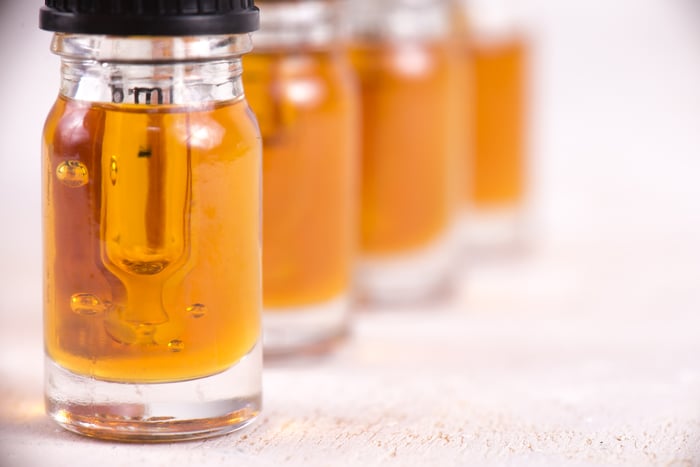After years of lobbying, the long wait in Canada will be over on Oct. 17, 2018. That's the date, according to Prime Minister Justin Trudeau, recreational marijuana will officially go on sale to adults.
Though domestic medical cannabis sales and exports to foreign countries where medical weed is legal have grown nicely in recent years, it simply doesn't compare to the recreational market, which might account for close to 90% of all domestic revenue by as soon as 2021 or 2022. In nominal terms, we're talking about the addition of $5 billion in annual sales. Ka-ching!

Image source: Getty Images.
Even the fast-growing legal cannabis industry has risks
While there's no denying that the Canadian cannabis industry will grow quickly, and it's pretty evident that the industry has a viable long-term business model, there are still abundant risks that investors should be aware of.
As an example, the way marijuana stocks have raised capital over the past two years could come back to haunt investors for a long time to come. Bought-deal offerings, whereby common stock, convertible debentures, stock options, and/or warrants were offered in exchange for capital that was used to expand production capacity, are likely to balloon outstanding share counts. Further, convertible debentures, options, and warrants, can be exercised months or years down the road, leading to ongoing dilutive effects. The issue with these offerings is that net income will be divided into a growing number of outstanding shares, adversely impacting earnings per share and making it really tough for fundamentally focused investors to support marijuana stock valuations.
Likewise, what little data we have on adult-use cannabis legalization suggests that the commoditization and oversupply of dried cannabis is right around the corner. In Colorado, Washington, and Oregon, oversupply ran rampant just a few short quarters after recreational pot went on sale. The result in all three cases has been a steady and sizable decline in the per-gram price for weed. With an unclear picture of exactly how much product foreign markets will gobble up, and my personal expectation that domestic oversupply will easily top 1 million kilograms by 2020 or 2021, Canada could be on track to deal with many of these same issues.
It's for reasons like these that I'm skeptical of most pot stocks.

Image source: Getty Images.
In a sea of frothy valuations, this marijuana stock stands out as my favorite
However, there is one grower that wades through the murkiness, so much so that I'd anoint it as my favorite marijuana stock (albeit with a caveat): OrganiGram Holdings (OGI -1.70%).
While Wall Street is busy focusing on the largest growers in the industry, such as Aurora Cannabis and Canopy Growth Corporation, I believe small-cap pot stocks offer the greatest risk-versus-reward profile. Among those small caps, OrganiGram stands out.
Recently, I had a chance to pose some hard-hitting questions to OrganiGram's CEO Greg Engel in an email interview, and his answers abated many of my concerns, while reinforcing a number of existing aspects about the company that I already liked.
Here's what makes OrganiGram so special
If I could narrow down the three things that investors need to know about OrganiGram Holdings, they would be:
- Low-cost production
- Diversified product line
- Under-the-radar Atlantic producer
In terms of keeping production costs low, OrganiGram's secret is twofold. First, its Moncton, New Brunswick, facility acts as its only production site. Slated for completion in April 2020, OrganiGram is able to keep its costs under control since it has just a single grow site to worry about. And secondly, the company's three levels of grow space maximize its approximately 490,000 square feet of capacity. Whereas most growers might struggle to produce 100,000 kilograms across 1 million square feet of growing capacity, OrganiGram upped its peak output to 113,000 kilograms over 490,000 square feet in March.

Image source: Getty Images.
When it comes to OrganiGram's products, I'm particularly pleased with how management has chosen to focus on oils and other dried cannabis alternatives. With the threat for dried cannabis oversupply and commoditization looming large by perhaps 2020, companies that focus on oils and other higher margin cannabis products that have a very low risk of commoditization should be able to pump out consistently beefier margins. According to Engel, approximately 50% of its medical cannabis-focused product line should be in high-margin oils, with edibles and infused products becoming an integral component of the company's product line in the future, once the Canadian federal government gives edibles and infused products a green light.
And finally, the email interview with Engel cued me into a reason I was overlooking as to why Wall Street had been (in my view) undervaluing the company: its growing location. Most of Canada's top growers are located in British Columbia, Ontario, or some other prominent province. Based in New Brunswick, OrganiGram's location has it flying under the radar. And by "under the radar," I mean valued at a forward price-to-earnings ratio of 26, which is markedly lower than its peers.
Now for that caveat...
Even though OrganiGram is my unquestioned top marijuana stock, the aforementioned caveat to that proclamation is that I'm not rushing to add it to my portfolio at this very moment. The reason why not is simple: history.

Image source: Getty Images.
History has shown time and again that investors overshoot when the new greatest thing since sliced bread becomes available. Whether it's the internet, business-to-business commerce, decoding the human genome, 3D printing, blockchain technology, or any of the many other "game changers" that've come along over the years, the pattern almost always results in a moderate-to-severe burst bubble.
Again, I want to be clear that I do believe the legal cannabis industry is here to stay, and I don't doubt that it can deliver steady long-term growth. The issue is that investor expectations and pot stock bottom lines simply don't add up right now. The industry needs time to mature, which probably means quite a few marijuana stocks are primed to fall -- perhaps even OrganiGram. While I've not ruled out establishing a small position and nibbling if OrganiGram's stock were to trend lower, I'd much prefer to wait for calmer waters before jumping in.





